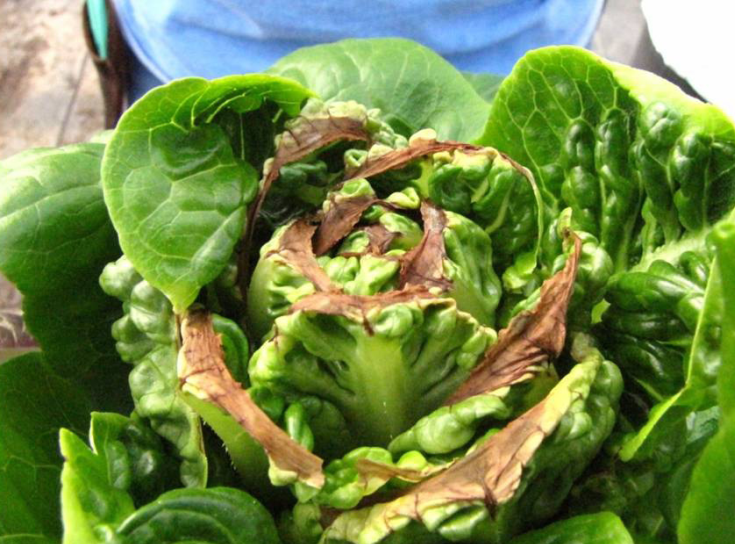The most common problem I get contacted for by hydroponic lettuce growers is the appearance of inner leaf tipburn within their plants. During the past 10 years I have consulted for dozens of growers and helped many of them solve this issue. There can be multiple causes for the problem but a careful evaluation of the crop can often lead to a viable solution. In today’s article I am going to talk about the main reasons why inner leaf tipburn is such a big problem with hydroponic lettuce, what can cause it and how it can be fixed.

What is this leaf tipburn issue? It appears as lettuce heads become adult plants, the tips of the inner lettuce leaves die off. This happens because of a lack of enough calcium at the edges of the leaves, which causes the rapidly growing tissue at the center of the lettuce head to start dying of. This does not happen at the outer leaves of the plant because these leaves get much more efficient nutrient transport, while the inner leaves receive a much more limited amount of calcium. In most hydroponic cases this is actually not related at all with a lack of calcium in the nutrient solution, but with the transport of the Calcium from the solution to the leaves. It is often the case in hydroponic crops that conditions are so favorable for fast growth that the leaves of the plant grow too fast and Calcium transport just cannot keep up (5, 6).
Due to the above it is common for measures that help with Ca absorption to also help with the elimination of this tipburn phenomenon. An effective change in the nutrient solution is to reduce the K:Ca ratio if this ratio is significantly high. Going from a solution that has a high ratio (say 3:1) to a solution with a ratio closer to 1.25:1 can heavily reduce tip burn by reducing the competition of K with Ca and facilitating Ca transport. Making it easier for the plant to move nutrients by reducing the EC of the solution can often lead to improvements in this issue, this is both because lower EC values reduce overall nutrient absorption, making growth slower, therefore enabling the Ca to be absorbed to meet the needs of the plant. You can see experimental evidence for the two suggestions above in (1). This is why lettuce formulated nutrients will generally have K:Ca ratios close to 1.25:1 and why the EC values recommended are usually in the 1-2mS/cm range, even though higher EC levels can indeed be more productive in terms of mass produced per day.

Since tipburn is related to how fast plants are grown, it is usually effective to reduce the light intensity in order to alleviate the tipburn problem (2). While growing lettuce at higher PPFD values can generate larger amounts of dry weight per day, it also correlates with a significantly larger amount of tipburn within the crop, precisely because growth is more aggressive. This, in combination with the fact that warmer temperatures further increase growth speed, is an important reason why there is significantly higher incidence of leaf tipburn in lettuce for crops that are produced during the spring/summer (3).
Environmental modifications to increase Ca transport can also be quite successful at helping prevent leaf tipburn, these can be particularly important when the desire to maximize yields as a function of time is fundamental (for example when growing lettuce in space). Constantly blowing air directly into the inner leaves of lettuce plants has been shown to effectively prevent the tipburn issue, as the constant stream of air increases nutrient transport to the lower leaves, by increasing evaporation and replenishing carbon dioxide (3,4). Note that these experiments are usually done in enriched CO2 environments, which is a modification that also helps with the issue.
One of the most practical approaches for the control and prevention of tip burn is also the application of calcium foliar sprays, with one of the most effective treatments – as it is also the case for many different crops – being the use of Calcium chloride (7). Treatments of crops twice a week with 400-800 ppm of Ca from calcium chloride can be quite effective in controlling tip burn with minimal decrease in yields. Additionally, calcium chloride can also be effective in the prevention of fungal disease which makes this proposition even more interesting. However, the use of foliar sprays like these requires a careful evaluation of the environmental conditions, as they can cause other problems if they are applied incorrectly.

In my experience, the correction of tip burn should start with an evaluation of the nutrient solution, to evaluate if enough calcium is present in solution, if the ratios of Ca to other cations, such as Mg, K and Na is correct and if salinity due to carbonates, Na, Cl or other such ions is too high. The EC can then be evaluated to determine whether it needs to be decreased to modify the growth rate and help alleviate the issue. Once the nutrient solution aspects are considered, the environmental conditions should be carefully evaluated to determine if changes to either temperature, relative humidity, air circulation, carbon dioxide concentration or light intensity are possible and if so, if they would be helpful. If the environmental conditions allow it, a foliar spray can also be formulated to supplement calcium to the crop using a highly available calcium salt – like Ca chloride – which should also help with the transport of Ca to leaf tissue.




